Cloud Computing in Business: Advantages, Disadvantages, and Analysis
VerifiedAdded on 2020/03/07
|11
|3090
|18
Report
AI Summary
This report provides a comprehensive overview of cloud computing, exploring its advantages and disadvantages within a business context. The report begins by defining cloud computing and its impact on business operations, highlighting its ability to outsource data and applications via virtual servers. The core of the report analyzes key benefits such as cost efficiency, improved backup and recovery processes, automation of software integration, scalability, and device diversity. It also delves into the disadvantages including security concerns, the potential for vendor lock-in, contractual obligations, technical issues such as outages, and a detailed cost analysis. The report emphasizes the importance of understanding both the benefits and the potential drawbacks to make informed decisions about cloud adoption and usage in business environments. The document aims to be a reference point for businesses considering the use of cloud computing and offers a clear understanding of the complexities involved.
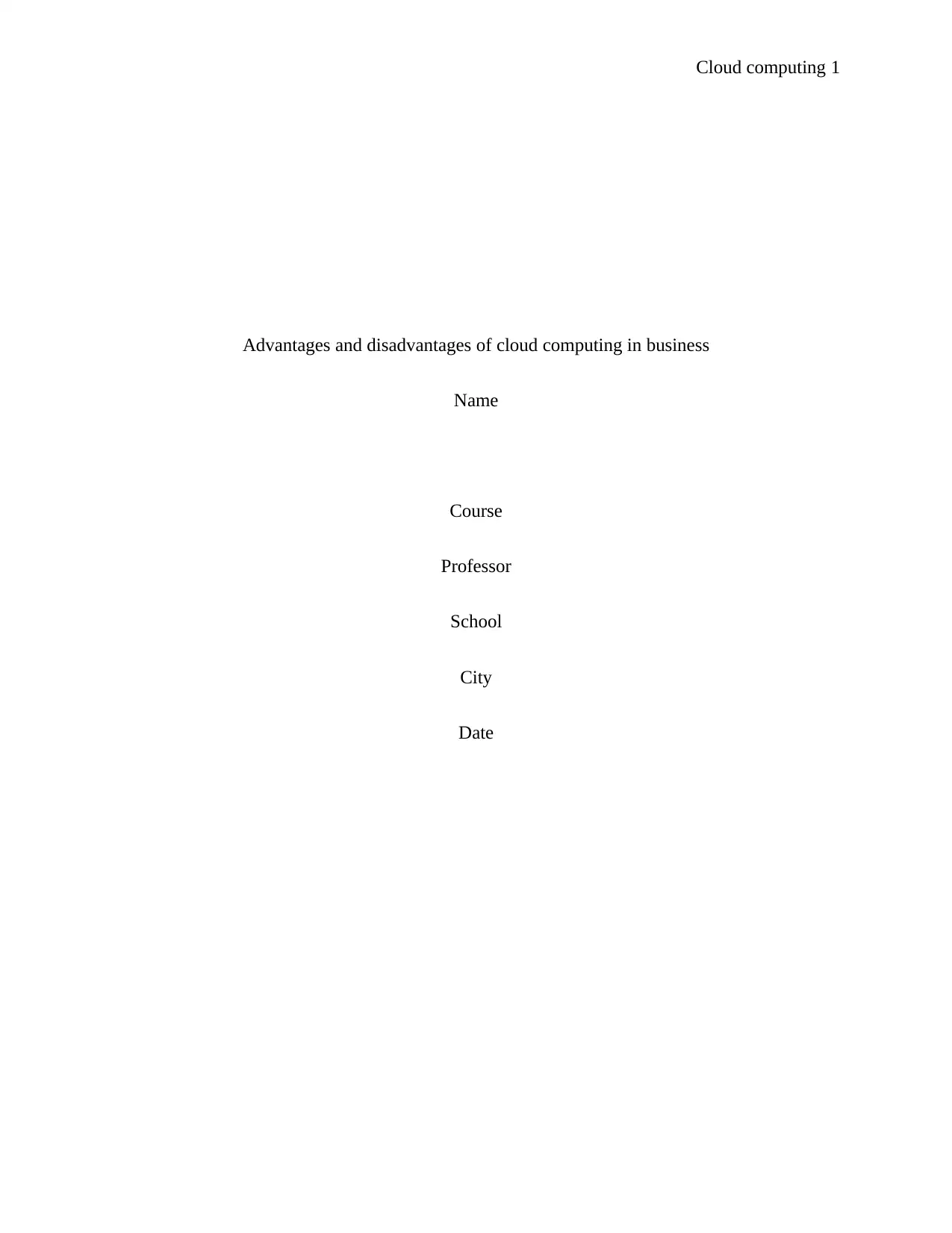
Cloud computing 1
Advantages and disadvantages of cloud computing in business
Name
Course
Professor
School
City
Date
Advantages and disadvantages of cloud computing in business
Name
Course
Professor
School
City
Date
Paraphrase This Document
Need a fresh take? Get an instant paraphrase of this document with our AI Paraphraser
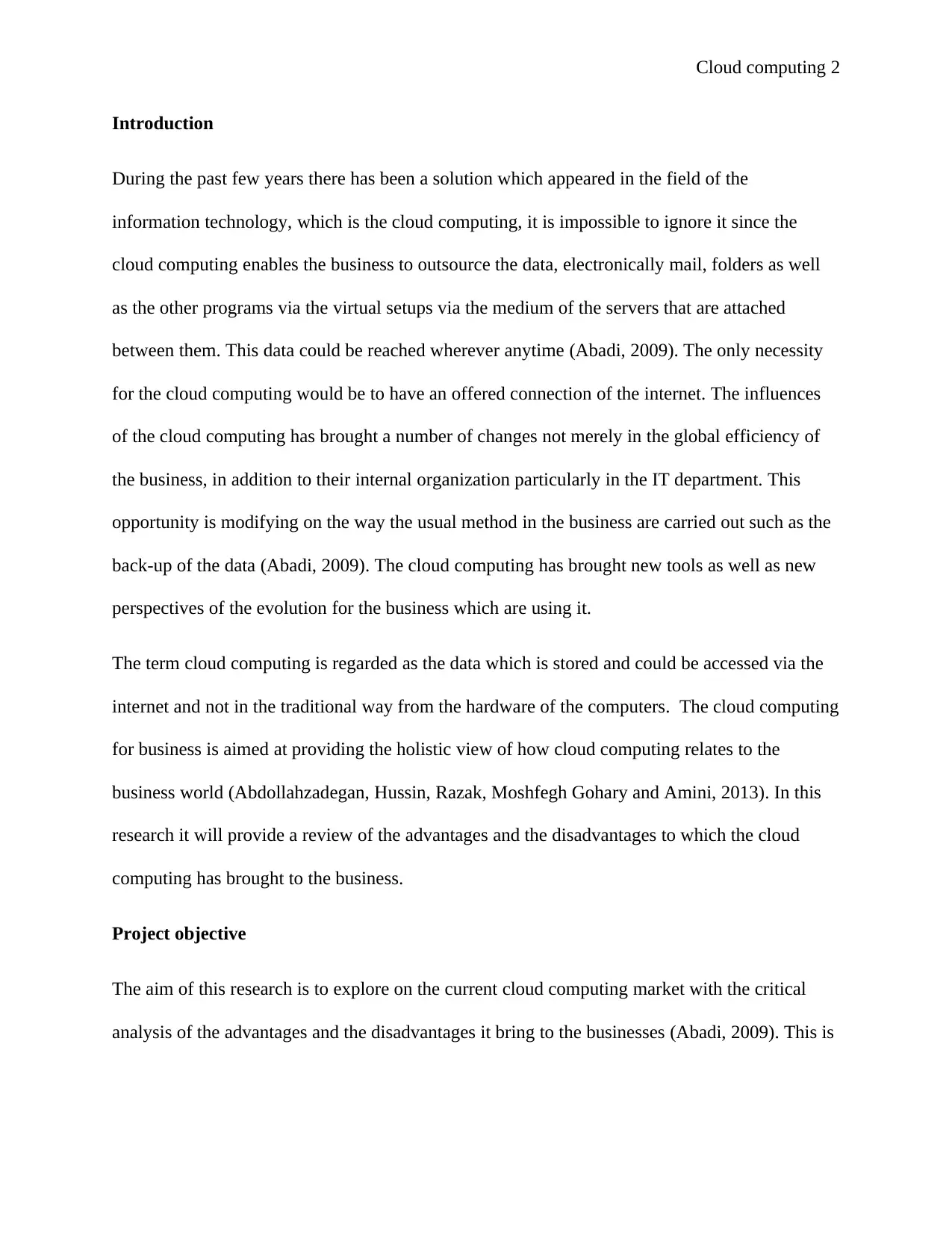
Cloud computing 2
Introduction
During the past few years there has been a solution which appeared in the field of the
information technology, which is the cloud computing, it is impossible to ignore it since the
cloud computing enables the business to outsource the data, electronically mail, folders as well
as the other programs via the virtual setups via the medium of the servers that are attached
between them. This data could be reached wherever anytime (Abadi, 2009). The only necessity
for the cloud computing would be to have an offered connection of the internet. The influences
of the cloud computing has brought a number of changes not merely in the global efficiency of
the business, in addition to their internal organization particularly in the IT department. This
opportunity is modifying on the way the usual method in the business are carried out such as the
back-up of the data (Abadi, 2009). The cloud computing has brought new tools as well as new
perspectives of the evolution for the business which are using it.
The term cloud computing is regarded as the data which is stored and could be accessed via the
internet and not in the traditional way from the hardware of the computers. The cloud computing
for business is aimed at providing the holistic view of how cloud computing relates to the
business world (Abdollahzadegan, Hussin, Razak, Moshfegh Gohary and Amini, 2013). In this
research it will provide a review of the advantages and the disadvantages to which the cloud
computing has brought to the business.
Project objective
The aim of this research is to explore on the current cloud computing market with the critical
analysis of the advantages and the disadvantages it bring to the businesses (Abadi, 2009). This is
Introduction
During the past few years there has been a solution which appeared in the field of the
information technology, which is the cloud computing, it is impossible to ignore it since the
cloud computing enables the business to outsource the data, electronically mail, folders as well
as the other programs via the virtual setups via the medium of the servers that are attached
between them. This data could be reached wherever anytime (Abadi, 2009). The only necessity
for the cloud computing would be to have an offered connection of the internet. The influences
of the cloud computing has brought a number of changes not merely in the global efficiency of
the business, in addition to their internal organization particularly in the IT department. This
opportunity is modifying on the way the usual method in the business are carried out such as the
back-up of the data (Abadi, 2009). The cloud computing has brought new tools as well as new
perspectives of the evolution for the business which are using it.
The term cloud computing is regarded as the data which is stored and could be accessed via the
internet and not in the traditional way from the hardware of the computers. The cloud computing
for business is aimed at providing the holistic view of how cloud computing relates to the
business world (Abdollahzadegan, Hussin, Razak, Moshfegh Gohary and Amini, 2013). In this
research it will provide a review of the advantages and the disadvantages to which the cloud
computing has brought to the business.
Project objective
The aim of this research is to explore on the current cloud computing market with the critical
analysis of the advantages and the disadvantages it bring to the businesses (Abadi, 2009). This is
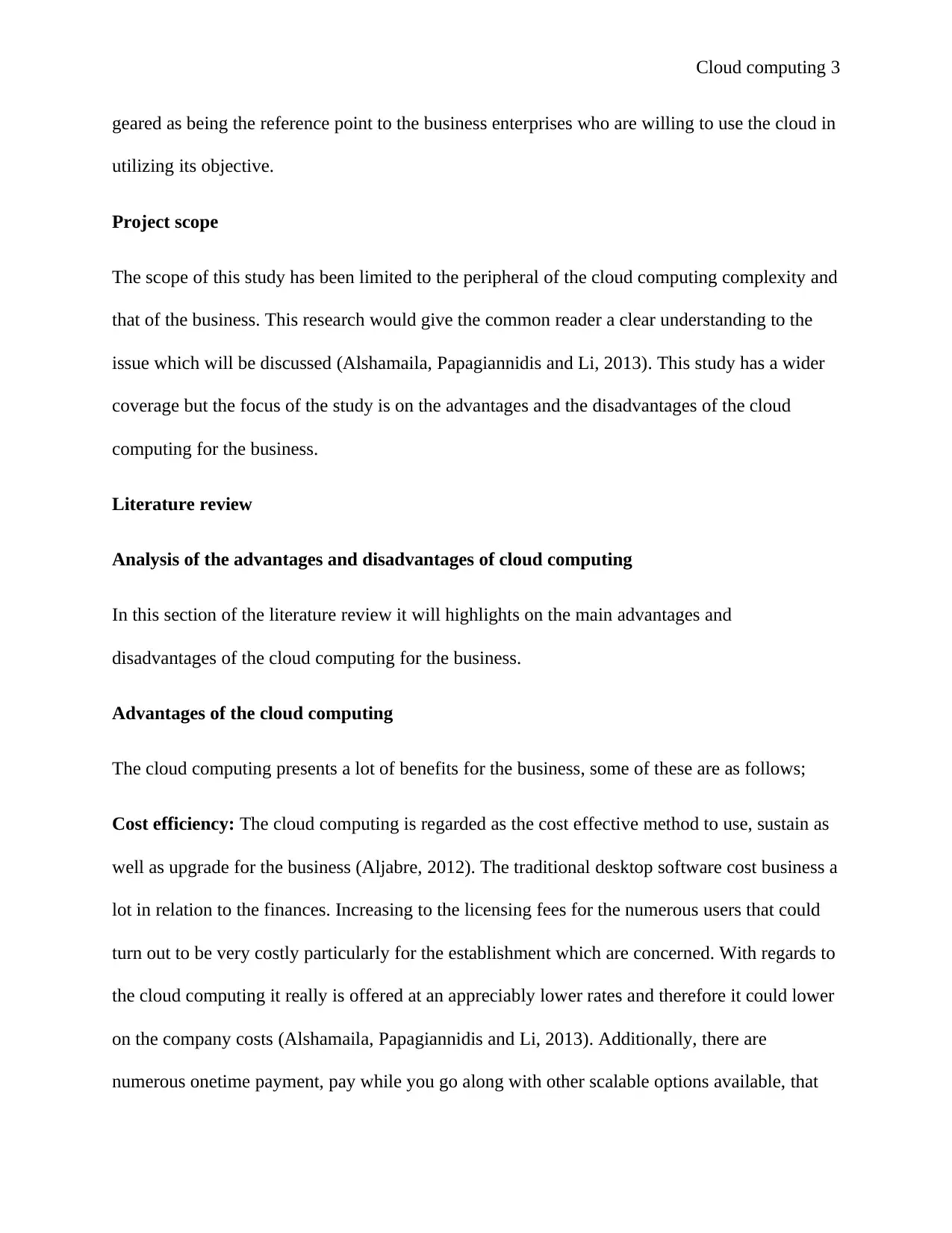
Cloud computing 3
geared as being the reference point to the business enterprises who are willing to use the cloud in
utilizing its objective.
Project scope
The scope of this study has been limited to the peripheral of the cloud computing complexity and
that of the business. This research would give the common reader a clear understanding to the
issue which will be discussed (Alshamaila, Papagiannidis and Li, 2013). This study has a wider
coverage but the focus of the study is on the advantages and the disadvantages of the cloud
computing for the business.
Literature review
Analysis of the advantages and disadvantages of cloud computing
In this section of the literature review it will highlights on the main advantages and
disadvantages of the cloud computing for the business.
Advantages of the cloud computing
The cloud computing presents a lot of benefits for the business, some of these are as follows;
Cost efficiency: The cloud computing is regarded as the cost effective method to use, sustain as
well as upgrade for the business (Aljabre, 2012). The traditional desktop software cost business a
lot in relation to the finances. Increasing to the licensing fees for the numerous users that could
turn out to be very costly particularly for the establishment which are concerned. With regards to
the cloud computing it really is offered at an appreciably lower rates and therefore it could lower
on the company costs (Alshamaila, Papagiannidis and Li, 2013). Additionally, there are
numerous onetime payment, pay while you go along with other scalable options available, that
geared as being the reference point to the business enterprises who are willing to use the cloud in
utilizing its objective.
Project scope
The scope of this study has been limited to the peripheral of the cloud computing complexity and
that of the business. This research would give the common reader a clear understanding to the
issue which will be discussed (Alshamaila, Papagiannidis and Li, 2013). This study has a wider
coverage but the focus of the study is on the advantages and the disadvantages of the cloud
computing for the business.
Literature review
Analysis of the advantages and disadvantages of cloud computing
In this section of the literature review it will highlights on the main advantages and
disadvantages of the cloud computing for the business.
Advantages of the cloud computing
The cloud computing presents a lot of benefits for the business, some of these are as follows;
Cost efficiency: The cloud computing is regarded as the cost effective method to use, sustain as
well as upgrade for the business (Aljabre, 2012). The traditional desktop software cost business a
lot in relation to the finances. Increasing to the licensing fees for the numerous users that could
turn out to be very costly particularly for the establishment which are concerned. With regards to
the cloud computing it really is offered at an appreciably lower rates and therefore it could lower
on the company costs (Alshamaila, Papagiannidis and Li, 2013). Additionally, there are
numerous onetime payment, pay while you go along with other scalable options available, that
⊘ This is a preview!⊘
Do you want full access?
Subscribe today to unlock all pages.

Trusted by 1+ million students worldwide
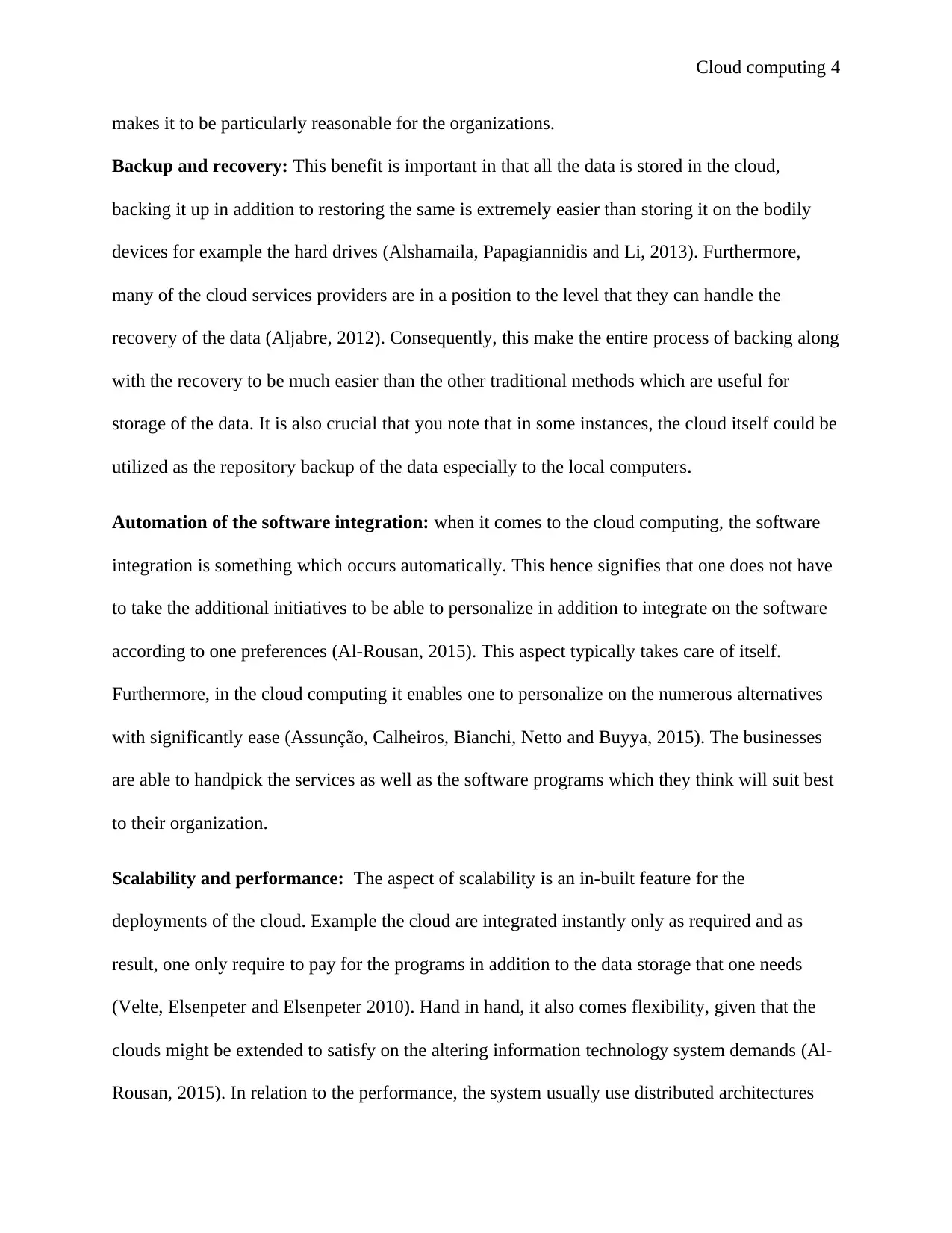
Cloud computing 4
makes it to be particularly reasonable for the organizations.
Backup and recovery: This benefit is important in that all the data is stored in the cloud,
backing it up in addition to restoring the same is extremely easier than storing it on the bodily
devices for example the hard drives (Alshamaila, Papagiannidis and Li, 2013). Furthermore,
many of the cloud services providers are in a position to the level that they can handle the
recovery of the data (Aljabre, 2012). Consequently, this make the entire process of backing along
with the recovery to be much easier than the other traditional methods which are useful for
storage of the data. It is also crucial that you note that in some instances, the cloud itself could be
utilized as the repository backup of the data especially to the local computers.
Automation of the software integration: when it comes to the cloud computing, the software
integration is something which occurs automatically. This hence signifies that one does not have
to take the additional initiatives to be able to personalize in addition to integrate on the software
according to one preferences (Al-Rousan, 2015). This aspect typically takes care of itself.
Furthermore, in the cloud computing it enables one to personalize on the numerous alternatives
with significantly ease (Assunção, Calheiros, Bianchi, Netto and Buyya, 2015). The businesses
are able to handpick the services as well as the software programs which they think will suit best
to their organization.
Scalability and performance: The aspect of scalability is an in-built feature for the
deployments of the cloud. Example the cloud are integrated instantly only as required and as
result, one only require to pay for the programs in addition to the data storage that one needs
(Velte, Elsenpeter and Elsenpeter 2010). Hand in hand, it also comes flexibility, given that the
clouds might be extended to satisfy on the altering information technology system demands (Al-
Rousan, 2015). In relation to the performance, the system usually use distributed architectures
makes it to be particularly reasonable for the organizations.
Backup and recovery: This benefit is important in that all the data is stored in the cloud,
backing it up in addition to restoring the same is extremely easier than storing it on the bodily
devices for example the hard drives (Alshamaila, Papagiannidis and Li, 2013). Furthermore,
many of the cloud services providers are in a position to the level that they can handle the
recovery of the data (Aljabre, 2012). Consequently, this make the entire process of backing along
with the recovery to be much easier than the other traditional methods which are useful for
storage of the data. It is also crucial that you note that in some instances, the cloud itself could be
utilized as the repository backup of the data especially to the local computers.
Automation of the software integration: when it comes to the cloud computing, the software
integration is something which occurs automatically. This hence signifies that one does not have
to take the additional initiatives to be able to personalize in addition to integrate on the software
according to one preferences (Al-Rousan, 2015). This aspect typically takes care of itself.
Furthermore, in the cloud computing it enables one to personalize on the numerous alternatives
with significantly ease (Assunção, Calheiros, Bianchi, Netto and Buyya, 2015). The businesses
are able to handpick the services as well as the software programs which they think will suit best
to their organization.
Scalability and performance: The aspect of scalability is an in-built feature for the
deployments of the cloud. Example the cloud are integrated instantly only as required and as
result, one only require to pay for the programs in addition to the data storage that one needs
(Velte, Elsenpeter and Elsenpeter 2010). Hand in hand, it also comes flexibility, given that the
clouds might be extended to satisfy on the altering information technology system demands (Al-
Rousan, 2015). In relation to the performance, the system usually use distributed architectures
Paraphrase This Document
Need a fresh take? Get an instant paraphrase of this document with our AI Paraphraser
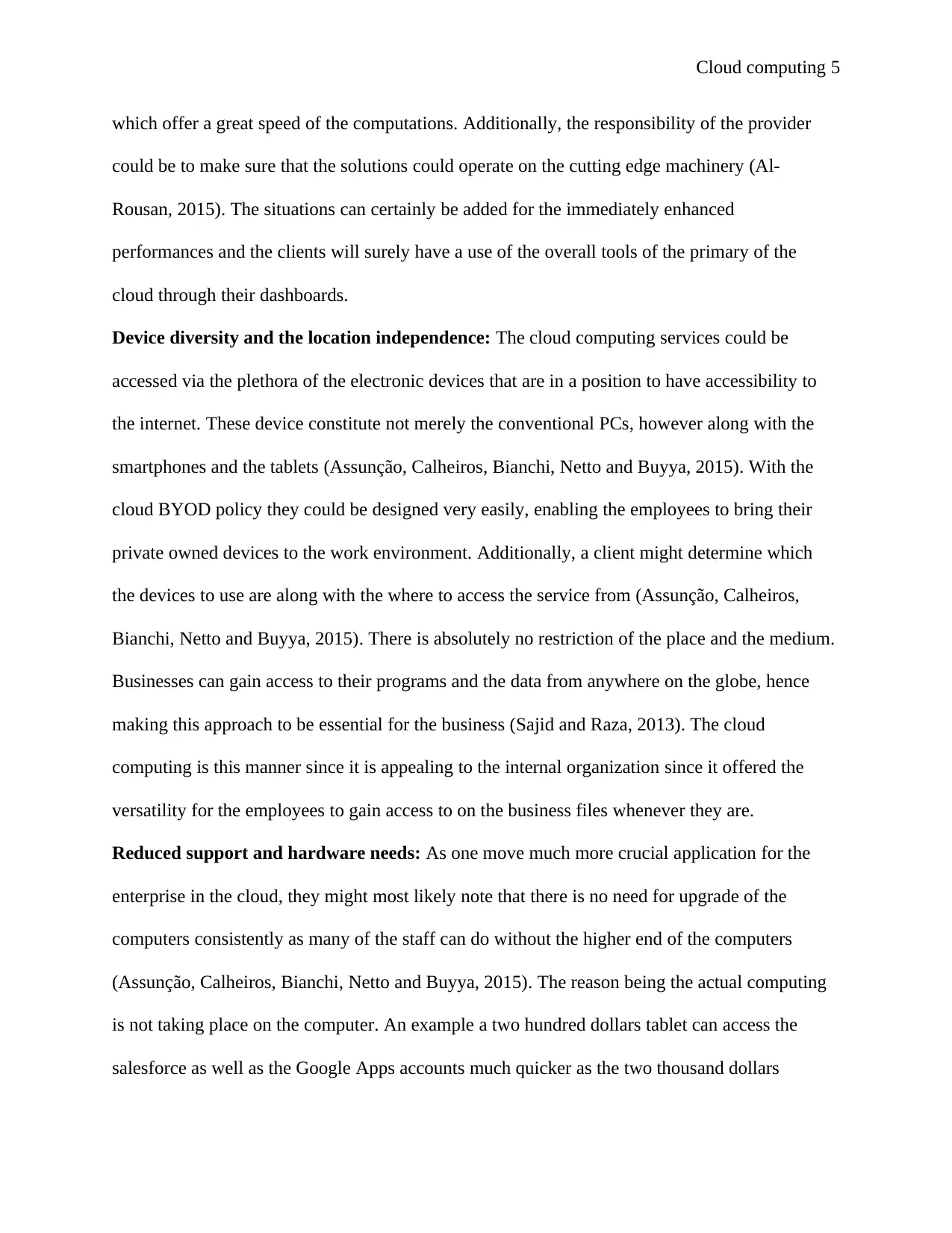
Cloud computing 5
which offer a great speed of the computations. Additionally, the responsibility of the provider
could be to make sure that the solutions could operate on the cutting edge machinery (Al-
Rousan, 2015). The situations can certainly be added for the immediately enhanced
performances and the clients will surely have a use of the overall tools of the primary of the
cloud through their dashboards.
Device diversity and the location independence: The cloud computing services could be
accessed via the plethora of the electronic devices that are in a position to have accessibility to
the internet. These device constitute not merely the conventional PCs, however along with the
smartphones and the tablets (Assunção, Calheiros, Bianchi, Netto and Buyya, 2015). With the
cloud BYOD policy they could be designed very easily, enabling the employees to bring their
private owned devices to the work environment. Additionally, a client might determine which
the devices to use are along with the where to access the service from (Assunção, Calheiros,
Bianchi, Netto and Buyya, 2015). There is absolutely no restriction of the place and the medium.
Businesses can gain access to their programs and the data from anywhere on the globe, hence
making this approach to be essential for the business (Sajid and Raza, 2013). The cloud
computing is this manner since it is appealing to the internal organization since it offered the
versatility for the employees to gain access to on the business files whenever they are.
Reduced support and hardware needs: As one move much more crucial application for the
enterprise in the cloud, they might most likely note that there is no need for upgrade of the
computers consistently as many of the staff can do without the higher end of the computers
(Assunção, Calheiros, Bianchi, Netto and Buyya, 2015). The reason being the actual computing
is not taking place on the computer. An example a two hundred dollars tablet can access the
salesforce as well as the Google Apps accounts much quicker as the two thousand dollars
which offer a great speed of the computations. Additionally, the responsibility of the provider
could be to make sure that the solutions could operate on the cutting edge machinery (Al-
Rousan, 2015). The situations can certainly be added for the immediately enhanced
performances and the clients will surely have a use of the overall tools of the primary of the
cloud through their dashboards.
Device diversity and the location independence: The cloud computing services could be
accessed via the plethora of the electronic devices that are in a position to have accessibility to
the internet. These device constitute not merely the conventional PCs, however along with the
smartphones and the tablets (Assunção, Calheiros, Bianchi, Netto and Buyya, 2015). With the
cloud BYOD policy they could be designed very easily, enabling the employees to bring their
private owned devices to the work environment. Additionally, a client might determine which
the devices to use are along with the where to access the service from (Assunção, Calheiros,
Bianchi, Netto and Buyya, 2015). There is absolutely no restriction of the place and the medium.
Businesses can gain access to their programs and the data from anywhere on the globe, hence
making this approach to be essential for the business (Sajid and Raza, 2013). The cloud
computing is this manner since it is appealing to the internal organization since it offered the
versatility for the employees to gain access to on the business files whenever they are.
Reduced support and hardware needs: As one move much more crucial application for the
enterprise in the cloud, they might most likely note that there is no need for upgrade of the
computers consistently as many of the staff can do without the higher end of the computers
(Assunção, Calheiros, Bianchi, Netto and Buyya, 2015). The reason being the actual computing
is not taking place on the computer. An example a two hundred dollars tablet can access the
salesforce as well as the Google Apps accounts much quicker as the two thousand dollars
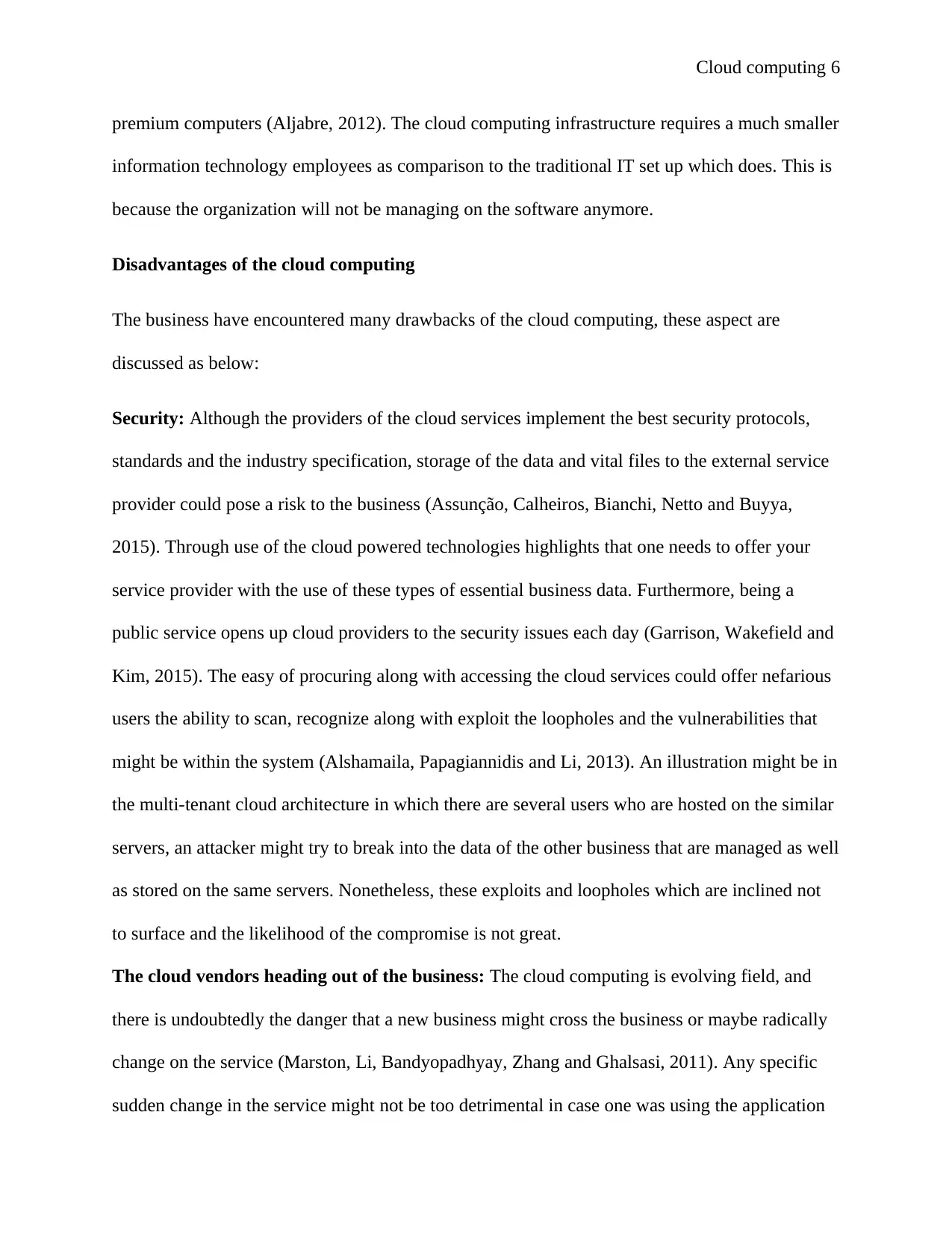
Cloud computing 6
premium computers (Aljabre, 2012). The cloud computing infrastructure requires a much smaller
information technology employees as comparison to the traditional IT set up which does. This is
because the organization will not be managing on the software anymore.
Disadvantages of the cloud computing
The business have encountered many drawbacks of the cloud computing, these aspect are
discussed as below:
Security: Although the providers of the cloud services implement the best security protocols,
standards and the industry specification, storage of the data and vital files to the external service
provider could pose a risk to the business (Assunção, Calheiros, Bianchi, Netto and Buyya,
2015). Through use of the cloud powered technologies highlights that one needs to offer your
service provider with the use of these types of essential business data. Furthermore, being a
public service opens up cloud providers to the security issues each day (Garrison, Wakefield and
Kim, 2015). The easy of procuring along with accessing the cloud services could offer nefarious
users the ability to scan, recognize along with exploit the loopholes and the vulnerabilities that
might be within the system (Alshamaila, Papagiannidis and Li, 2013). An illustration might be in
the multi-tenant cloud architecture in which there are several users who are hosted on the similar
servers, an attacker might try to break into the data of the other business that are managed as well
as stored on the same servers. Nonetheless, these exploits and loopholes which are inclined not
to surface and the likelihood of the compromise is not great.
The cloud vendors heading out of the business: The cloud computing is evolving field, and
there is undoubtedly the danger that a new business might cross the business or maybe radically
change on the service (Marston, Li, Bandyopadhyay, Zhang and Ghalsasi, 2011). Any specific
sudden change in the service might not be too detrimental in case one was using the application
premium computers (Aljabre, 2012). The cloud computing infrastructure requires a much smaller
information technology employees as comparison to the traditional IT set up which does. This is
because the organization will not be managing on the software anymore.
Disadvantages of the cloud computing
The business have encountered many drawbacks of the cloud computing, these aspect are
discussed as below:
Security: Although the providers of the cloud services implement the best security protocols,
standards and the industry specification, storage of the data and vital files to the external service
provider could pose a risk to the business (Assunção, Calheiros, Bianchi, Netto and Buyya,
2015). Through use of the cloud powered technologies highlights that one needs to offer your
service provider with the use of these types of essential business data. Furthermore, being a
public service opens up cloud providers to the security issues each day (Garrison, Wakefield and
Kim, 2015). The easy of procuring along with accessing the cloud services could offer nefarious
users the ability to scan, recognize along with exploit the loopholes and the vulnerabilities that
might be within the system (Alshamaila, Papagiannidis and Li, 2013). An illustration might be in
the multi-tenant cloud architecture in which there are several users who are hosted on the similar
servers, an attacker might try to break into the data of the other business that are managed as well
as stored on the same servers. Nonetheless, these exploits and loopholes which are inclined not
to surface and the likelihood of the compromise is not great.
The cloud vendors heading out of the business: The cloud computing is evolving field, and
there is undoubtedly the danger that a new business might cross the business or maybe radically
change on the service (Marston, Li, Bandyopadhyay, Zhang and Ghalsasi, 2011). Any specific
sudden change in the service might not be too detrimental in case one was using the application
⊘ This is a preview!⊘
Do you want full access?
Subscribe today to unlock all pages.

Trusted by 1+ million students worldwide
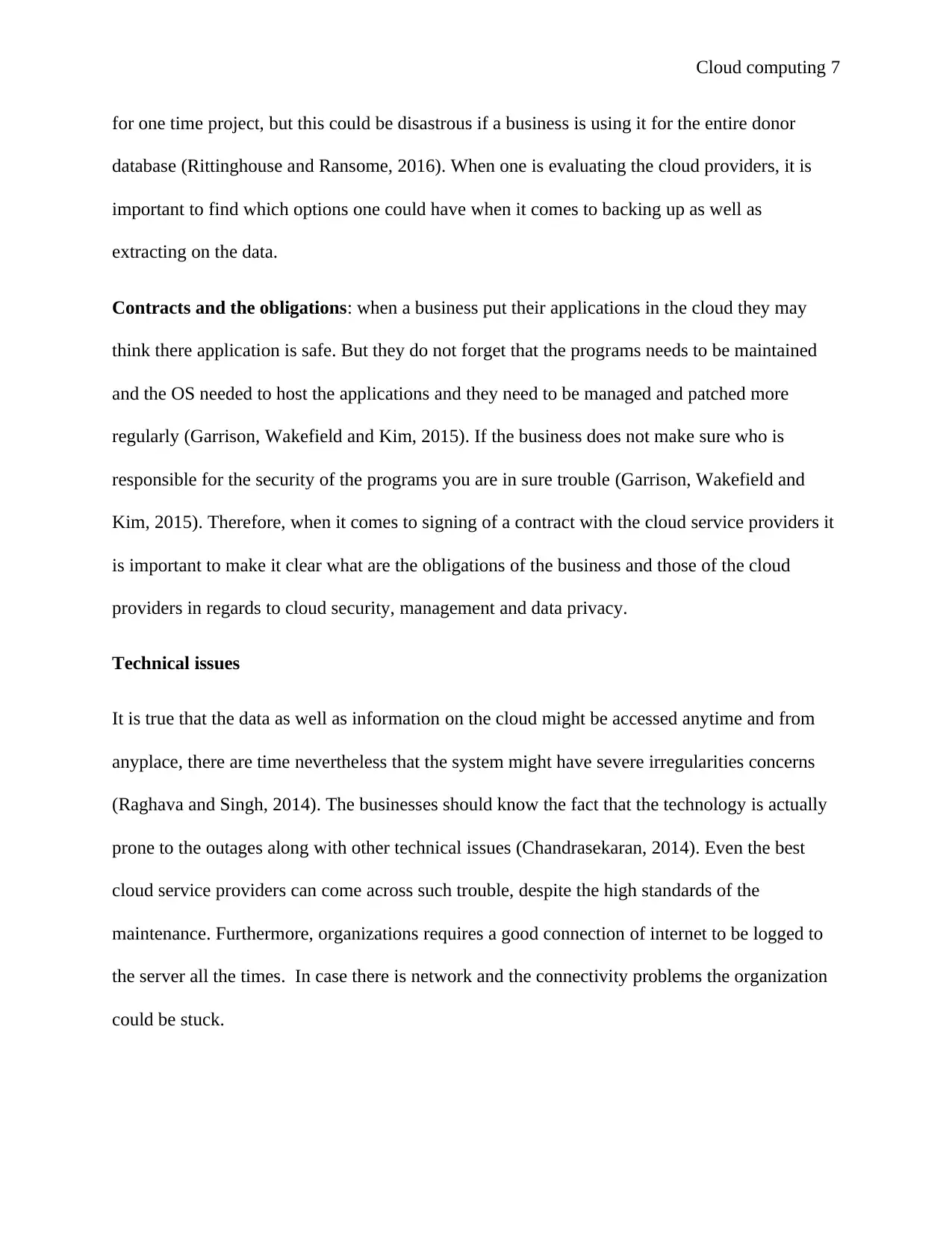
Cloud computing 7
for one time project, but this could be disastrous if a business is using it for the entire donor
database (Rittinghouse and Ransome, 2016). When one is evaluating the cloud providers, it is
important to find which options one could have when it comes to backing up as well as
extracting on the data.
Contracts and the obligations: when a business put their applications in the cloud they may
think there application is safe. But they do not forget that the programs needs to be maintained
and the OS needed to host the applications and they need to be managed and patched more
regularly (Garrison, Wakefield and Kim, 2015). If the business does not make sure who is
responsible for the security of the programs you are in sure trouble (Garrison, Wakefield and
Kim, 2015). Therefore, when it comes to signing of a contract with the cloud service providers it
is important to make it clear what are the obligations of the business and those of the cloud
providers in regards to cloud security, management and data privacy.
Technical issues
It is true that the data as well as information on the cloud might be accessed anytime and from
anyplace, there are time nevertheless that the system might have severe irregularities concerns
(Raghava and Singh, 2014). The businesses should know the fact that the technology is actually
prone to the outages along with other technical issues (Chandrasekaran, 2014). Even the best
cloud service providers can come across such trouble, despite the high standards of the
maintenance. Furthermore, organizations requires a good connection of internet to be logged to
the server all the times. In case there is network and the connectivity problems the organization
could be stuck.
for one time project, but this could be disastrous if a business is using it for the entire donor
database (Rittinghouse and Ransome, 2016). When one is evaluating the cloud providers, it is
important to find which options one could have when it comes to backing up as well as
extracting on the data.
Contracts and the obligations: when a business put their applications in the cloud they may
think there application is safe. But they do not forget that the programs needs to be maintained
and the OS needed to host the applications and they need to be managed and patched more
regularly (Garrison, Wakefield and Kim, 2015). If the business does not make sure who is
responsible for the security of the programs you are in sure trouble (Garrison, Wakefield and
Kim, 2015). Therefore, when it comes to signing of a contract with the cloud service providers it
is important to make it clear what are the obligations of the business and those of the cloud
providers in regards to cloud security, management and data privacy.
Technical issues
It is true that the data as well as information on the cloud might be accessed anytime and from
anyplace, there are time nevertheless that the system might have severe irregularities concerns
(Raghava and Singh, 2014). The businesses should know the fact that the technology is actually
prone to the outages along with other technical issues (Chandrasekaran, 2014). Even the best
cloud service providers can come across such trouble, despite the high standards of the
maintenance. Furthermore, organizations requires a good connection of internet to be logged to
the server all the times. In case there is network and the connectivity problems the organization
could be stuck.
Paraphrase This Document
Need a fresh take? Get an instant paraphrase of this document with our AI Paraphraser
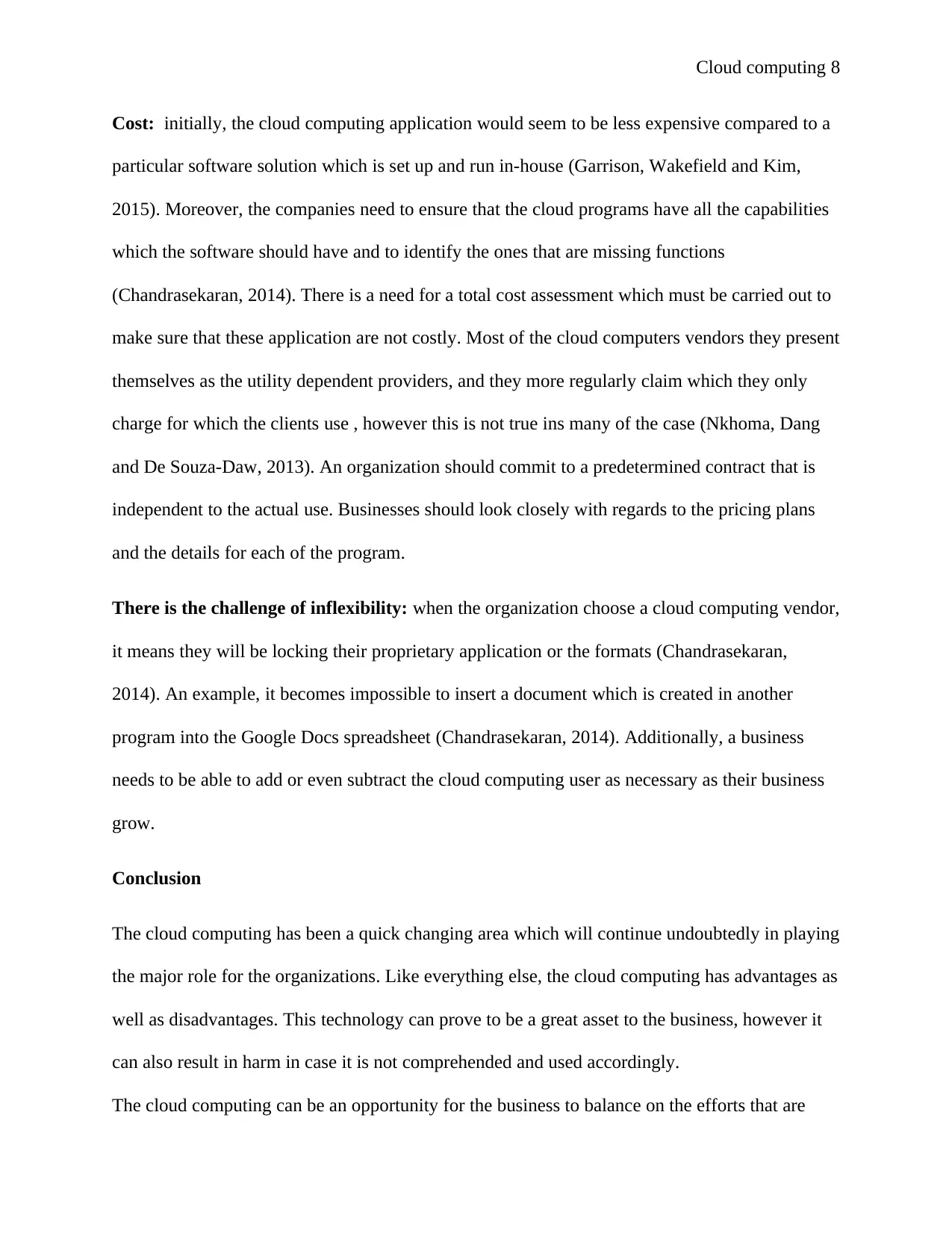
Cloud computing 8
Cost: initially, the cloud computing application would seem to be less expensive compared to a
particular software solution which is set up and run in-house (Garrison, Wakefield and Kim,
2015). Moreover, the companies need to ensure that the cloud programs have all the capabilities
which the software should have and to identify the ones that are missing functions
(Chandrasekaran, 2014). There is a need for a total cost assessment which must be carried out to
make sure that these application are not costly. Most of the cloud computers vendors they present
themselves as the utility dependent providers, and they more regularly claim which they only
charge for which the clients use , however this is not true ins many of the case (Nkhoma, Dang
and De Souza-Daw, 2013). An organization should commit to a predetermined contract that is
independent to the actual use. Businesses should look closely with regards to the pricing plans
and the details for each of the program.
There is the challenge of inflexibility: when the organization choose a cloud computing vendor,
it means they will be locking their proprietary application or the formats (Chandrasekaran,
2014). An example, it becomes impossible to insert a document which is created in another
program into the Google Docs spreadsheet (Chandrasekaran, 2014). Additionally, a business
needs to be able to add or even subtract the cloud computing user as necessary as their business
grow.
Conclusion
The cloud computing has been a quick changing area which will continue undoubtedly in playing
the major role for the organizations. Like everything else, the cloud computing has advantages as
well as disadvantages. This technology can prove to be a great asset to the business, however it
can also result in harm in case it is not comprehended and used accordingly.
The cloud computing can be an opportunity for the business to balance on the efforts that are
Cost: initially, the cloud computing application would seem to be less expensive compared to a
particular software solution which is set up and run in-house (Garrison, Wakefield and Kim,
2015). Moreover, the companies need to ensure that the cloud programs have all the capabilities
which the software should have and to identify the ones that are missing functions
(Chandrasekaran, 2014). There is a need for a total cost assessment which must be carried out to
make sure that these application are not costly. Most of the cloud computers vendors they present
themselves as the utility dependent providers, and they more regularly claim which they only
charge for which the clients use , however this is not true ins many of the case (Nkhoma, Dang
and De Souza-Daw, 2013). An organization should commit to a predetermined contract that is
independent to the actual use. Businesses should look closely with regards to the pricing plans
and the details for each of the program.
There is the challenge of inflexibility: when the organization choose a cloud computing vendor,
it means they will be locking their proprietary application or the formats (Chandrasekaran,
2014). An example, it becomes impossible to insert a document which is created in another
program into the Google Docs spreadsheet (Chandrasekaran, 2014). Additionally, a business
needs to be able to add or even subtract the cloud computing user as necessary as their business
grow.
Conclusion
The cloud computing has been a quick changing area which will continue undoubtedly in playing
the major role for the organizations. Like everything else, the cloud computing has advantages as
well as disadvantages. This technology can prove to be a great asset to the business, however it
can also result in harm in case it is not comprehended and used accordingly.
The cloud computing can be an opportunity for the business to balance on the efforts that are
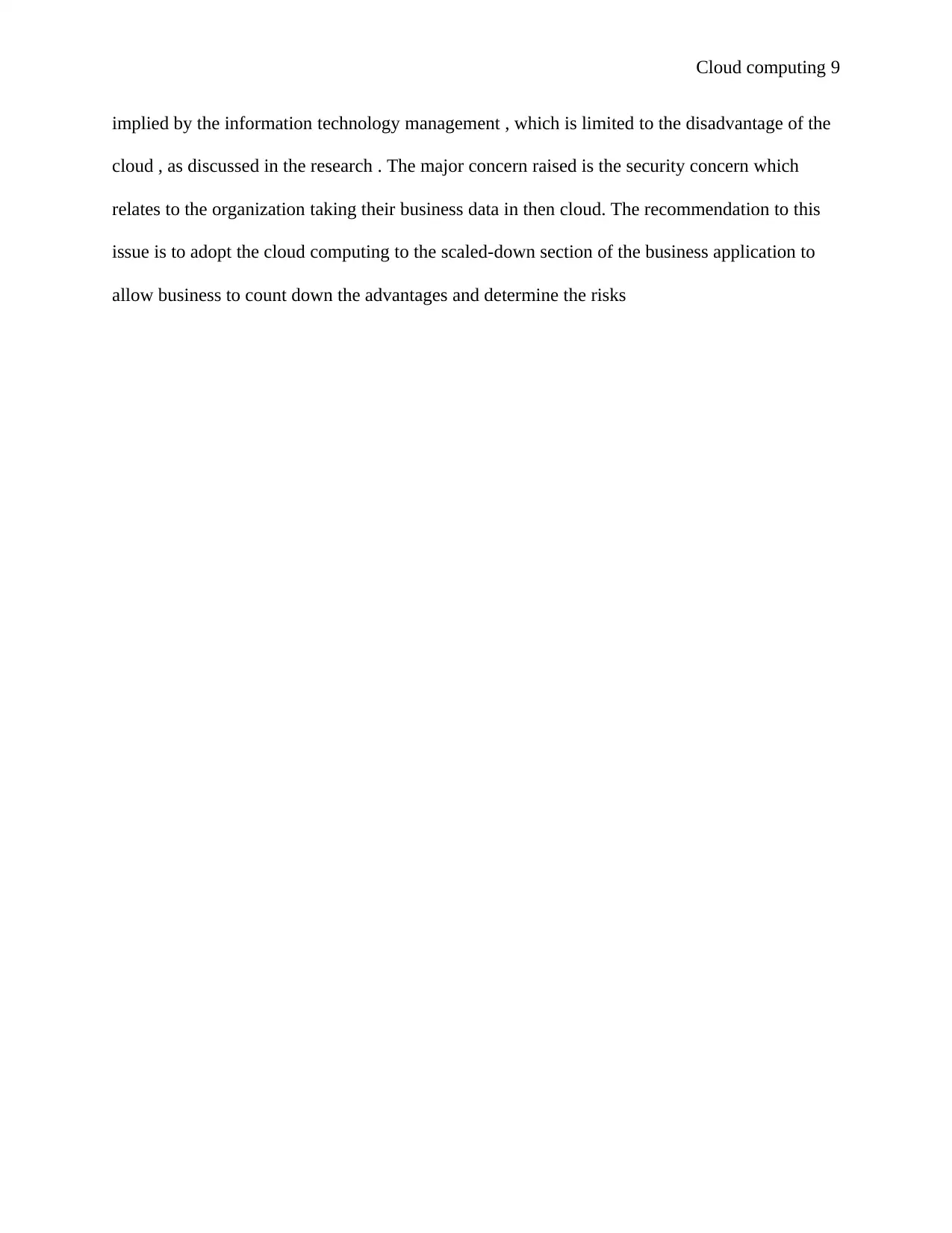
Cloud computing 9
implied by the information technology management , which is limited to the disadvantage of the
cloud , as discussed in the research . The major concern raised is the security concern which
relates to the organization taking their business data in then cloud. The recommendation to this
issue is to adopt the cloud computing to the scaled-down section of the business application to
allow business to count down the advantages and determine the risks
implied by the information technology management , which is limited to the disadvantage of the
cloud , as discussed in the research . The major concern raised is the security concern which
relates to the organization taking their business data in then cloud. The recommendation to this
issue is to adopt the cloud computing to the scaled-down section of the business application to
allow business to count down the advantages and determine the risks
⊘ This is a preview!⊘
Do you want full access?
Subscribe today to unlock all pages.

Trusted by 1+ million students worldwide
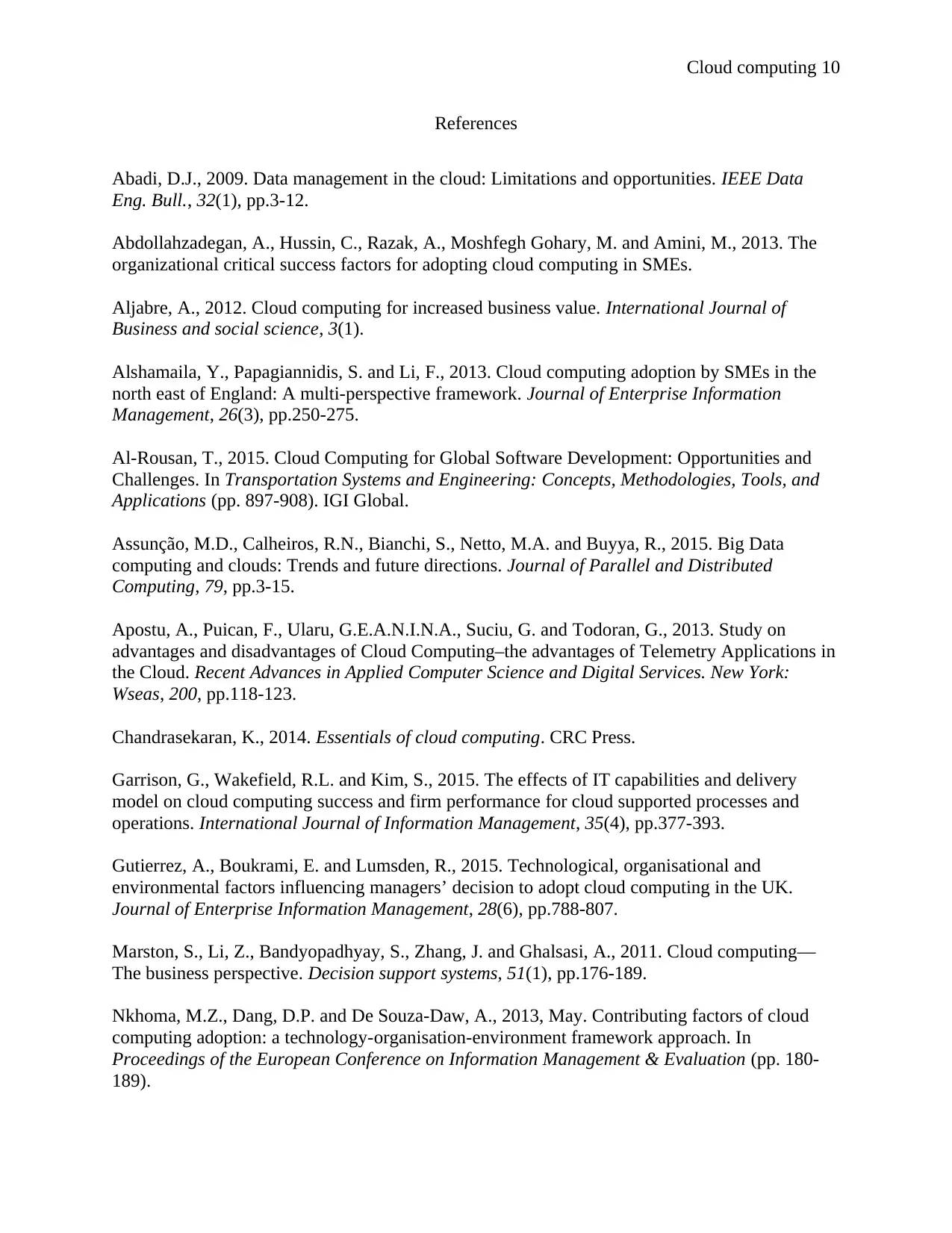
Cloud computing 10
References
Abadi, D.J., 2009. Data management in the cloud: Limitations and opportunities. IEEE Data
Eng. Bull., 32(1), pp.3-12.
Abdollahzadegan, A., Hussin, C., Razak, A., Moshfegh Gohary, M. and Amini, M., 2013. The
organizational critical success factors for adopting cloud computing in SMEs.
Aljabre, A., 2012. Cloud computing for increased business value. International Journal of
Business and social science, 3(1).
Alshamaila, Y., Papagiannidis, S. and Li, F., 2013. Cloud computing adoption by SMEs in the
north east of England: A multi-perspective framework. Journal of Enterprise Information
Management, 26(3), pp.250-275.
Al-Rousan, T., 2015. Cloud Computing for Global Software Development: Opportunities and
Challenges. In Transportation Systems and Engineering: Concepts, Methodologies, Tools, and
Applications (pp. 897-908). IGI Global.
Assunção, M.D., Calheiros, R.N., Bianchi, S., Netto, M.A. and Buyya, R., 2015. Big Data
computing and clouds: Trends and future directions. Journal of Parallel and Distributed
Computing, 79, pp.3-15.
Apostu, A., Puican, F., Ularu, G.E.A.N.I.N.A., Suciu, G. and Todoran, G., 2013. Study on
advantages and disadvantages of Cloud Computing–the advantages of Telemetry Applications in
the Cloud. Recent Advances in Applied Computer Science and Digital Services. New York:
Wseas, 200, pp.118-123.
Chandrasekaran, K., 2014. Essentials of cloud computing. CRC Press.
Garrison, G., Wakefield, R.L. and Kim, S., 2015. The effects of IT capabilities and delivery
model on cloud computing success and firm performance for cloud supported processes and
operations. International Journal of Information Management, 35(4), pp.377-393.
Gutierrez, A., Boukrami, E. and Lumsden, R., 2015. Technological, organisational and
environmental factors influencing managers’ decision to adopt cloud computing in the UK.
Journal of Enterprise Information Management, 28(6), pp.788-807.
Marston, S., Li, Z., Bandyopadhyay, S., Zhang, J. and Ghalsasi, A., 2011. Cloud computing—
The business perspective. Decision support systems, 51(1), pp.176-189.
Nkhoma, M.Z., Dang, D.P. and De Souza-Daw, A., 2013, May. Contributing factors of cloud
computing adoption: a technology-organisation-environment framework approach. In
Proceedings of the European Conference on Information Management & Evaluation (pp. 180-
189).
References
Abadi, D.J., 2009. Data management in the cloud: Limitations and opportunities. IEEE Data
Eng. Bull., 32(1), pp.3-12.
Abdollahzadegan, A., Hussin, C., Razak, A., Moshfegh Gohary, M. and Amini, M., 2013. The
organizational critical success factors for adopting cloud computing in SMEs.
Aljabre, A., 2012. Cloud computing for increased business value. International Journal of
Business and social science, 3(1).
Alshamaila, Y., Papagiannidis, S. and Li, F., 2013. Cloud computing adoption by SMEs in the
north east of England: A multi-perspective framework. Journal of Enterprise Information
Management, 26(3), pp.250-275.
Al-Rousan, T., 2015. Cloud Computing for Global Software Development: Opportunities and
Challenges. In Transportation Systems and Engineering: Concepts, Methodologies, Tools, and
Applications (pp. 897-908). IGI Global.
Assunção, M.D., Calheiros, R.N., Bianchi, S., Netto, M.A. and Buyya, R., 2015. Big Data
computing and clouds: Trends and future directions. Journal of Parallel and Distributed
Computing, 79, pp.3-15.
Apostu, A., Puican, F., Ularu, G.E.A.N.I.N.A., Suciu, G. and Todoran, G., 2013. Study on
advantages and disadvantages of Cloud Computing–the advantages of Telemetry Applications in
the Cloud. Recent Advances in Applied Computer Science and Digital Services. New York:
Wseas, 200, pp.118-123.
Chandrasekaran, K., 2014. Essentials of cloud computing. CRC Press.
Garrison, G., Wakefield, R.L. and Kim, S., 2015. The effects of IT capabilities and delivery
model on cloud computing success and firm performance for cloud supported processes and
operations. International Journal of Information Management, 35(4), pp.377-393.
Gutierrez, A., Boukrami, E. and Lumsden, R., 2015. Technological, organisational and
environmental factors influencing managers’ decision to adopt cloud computing in the UK.
Journal of Enterprise Information Management, 28(6), pp.788-807.
Marston, S., Li, Z., Bandyopadhyay, S., Zhang, J. and Ghalsasi, A., 2011. Cloud computing—
The business perspective. Decision support systems, 51(1), pp.176-189.
Nkhoma, M.Z., Dang, D.P. and De Souza-Daw, A., 2013, May. Contributing factors of cloud
computing adoption: a technology-organisation-environment framework approach. In
Proceedings of the European Conference on Information Management & Evaluation (pp. 180-
189).
Paraphrase This Document
Need a fresh take? Get an instant paraphrase of this document with our AI Paraphraser
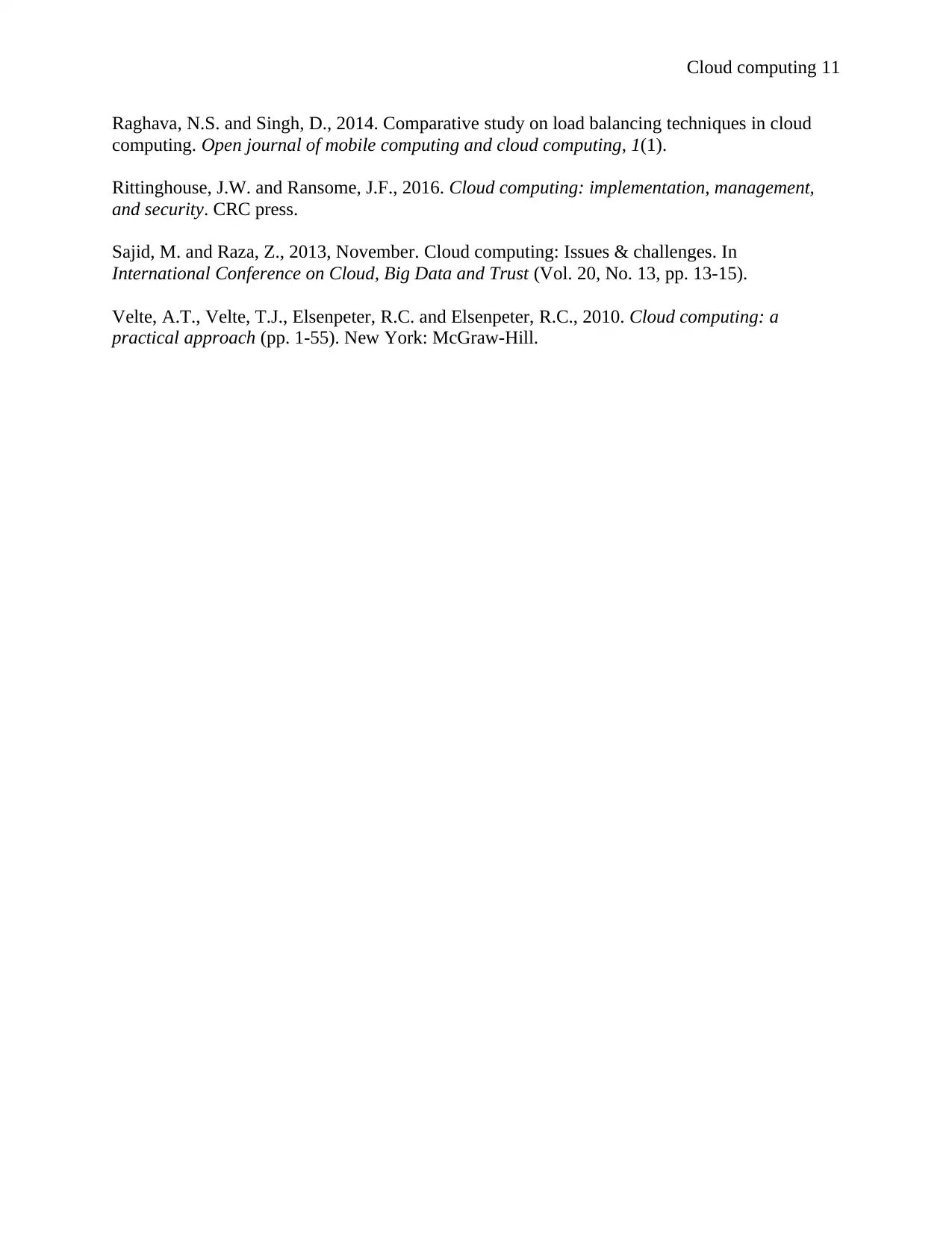
Cloud computing 11
Raghava, N.S. and Singh, D., 2014. Comparative study on load balancing techniques in cloud
computing. Open journal of mobile computing and cloud computing, 1(1).
Rittinghouse, J.W. and Ransome, J.F., 2016. Cloud computing: implementation, management,
and security. CRC press.
Sajid, M. and Raza, Z., 2013, November. Cloud computing: Issues & challenges. In
International Conference on Cloud, Big Data and Trust (Vol. 20, No. 13, pp. 13-15).
Velte, A.T., Velte, T.J., Elsenpeter, R.C. and Elsenpeter, R.C., 2010. Cloud computing: a
practical approach (pp. 1-55). New York: McGraw-Hill.
Raghava, N.S. and Singh, D., 2014. Comparative study on load balancing techniques in cloud
computing. Open journal of mobile computing and cloud computing, 1(1).
Rittinghouse, J.W. and Ransome, J.F., 2016. Cloud computing: implementation, management,
and security. CRC press.
Sajid, M. and Raza, Z., 2013, November. Cloud computing: Issues & challenges. In
International Conference on Cloud, Big Data and Trust (Vol. 20, No. 13, pp. 13-15).
Velte, A.T., Velte, T.J., Elsenpeter, R.C. and Elsenpeter, R.C., 2010. Cloud computing: a
practical approach (pp. 1-55). New York: McGraw-Hill.
1 out of 11
Related Documents
Your All-in-One AI-Powered Toolkit for Academic Success.
+13062052269
info@desklib.com
Available 24*7 on WhatsApp / Email
![[object Object]](/_next/static/media/star-bottom.7253800d.svg)
Unlock your academic potential
Copyright © 2020–2025 A2Z Services. All Rights Reserved. Developed and managed by ZUCOL.





